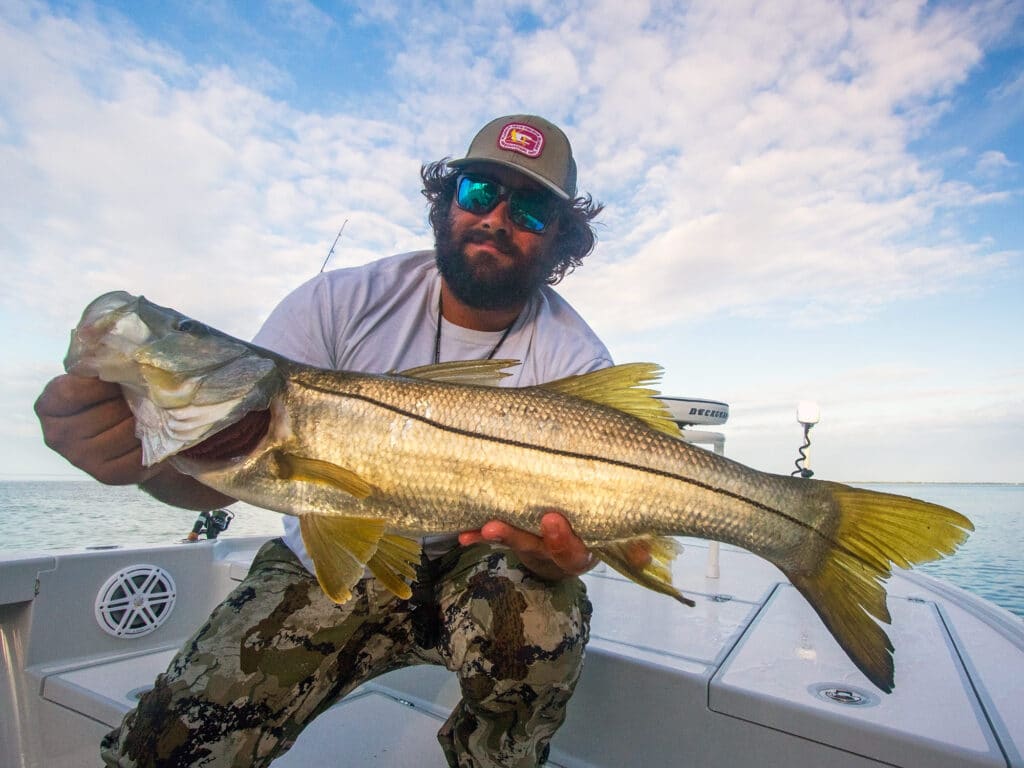
New regulations for snook fishing in Florida, effective January 1, 2024, establish nine snook management zones around the state along with seasons and slot limits for each zone. The new zones, like those established by the Florida Fish and Wildlife Conservation Commission (FWC) for redfish in 2022, allow for a more regionalized and responsive approach to managing snook fishing in Florida’s waters, FWC officials say.
“These regions and regulations are part of our holistic management approach for Florida’s most popular inshore fisheries,” said Emily Abellera, FWC’s Public Information Specialist. “Through this approach, seven metrics are used to evaluate the snook fishery by region, which adds a holistic perspective to management decisions and allows our fisheries managers to be more responsive to regional concerns.”
Those considerations for management of snook include fishing pressure, relative abundance, habitat, stakeholder feedback, spawning potential ratio, air temperature, and harmful algal blooms in local waters. Assessments of these factors will be registered in the annual review of the fishery, which is available for each zone on the FWC’s website.
These localized annual reviews contain vital information about snook in each management zone in a brief, condensed, and graphic format. If an angler wants to know more about a local region’s fishery — possibly their home waters — these reviews are a terrific place to learn. They’re also available for redfish.
The FWC’s approach reflects the increasingly important role of habitat quality in fisheries management in contrast to the overwhelming importance of population assessments that dominated management policy in past years.

“It’s good to see FWC is managing snook through specific regions,” said Giles Murphy, owner of Stuart Angler Bait and Tackle in Martin County. His local waters of the southern Indian River Lagoon are known to produce some of Florida’s biggest snook. “In our area, the seagrass is extremely vital in our ecosystem, and it’s been dying off for 20 years. Now it’s completely gone. The redfish and seatrout fishing has suffered because of it. The snook can adapt and live through it, but that might not last forever with development increasing faster every year,” Murphy said.
The new zones will provide geographic boundaries for any urgent regulation changes caused by local conditions. In 2018, snook and redfish were declared catch-and-release only along parts of the west coast due to red tide. Extreme cold weather has also caused emergency closures to snook seasons in parts of Florida in the past.
Years ago, Ron Taylor, the snook researcher who helped guide the FWC’s snook management for decades, told me that management aimed to produce consistent numbers of all size classes of snook including slot-sized fish for anglers to keep and over-slot, trophy fish that anglers can brag about.
“Those goals haven’t changed,” Abellera, of the FWC, assured me recently. “What’s new with the holistic regional management approach is that we are judging whether our regulations are meeting those goals using more metrics, and we’re evaluating our success on a smaller scale that better reflects the anglers’ experiences,” she said.
At this time, the main change to last year’s regulations in the new management zones affect two areas on the Gulf Coast.
“For the Charlotte Harbor and Southwest snook management regions, the summer closure now includes the month of September,” said Abellera. “This is one month longer than the other Gulf Coast management regions. Extending the summer season closure provides additional protection for snook during a portion of their spawning period that overlaps with the typical occurrence of red tide in these regions.”
Snook season opens Feb. 1 in the three east coast zones (Southeast, Indian River Lagoon and Northeast) and snook season opens March 1 in the rest of Florida’s zones. Slot and catch limits remain the same. The slot limit is currently 28 to 33 inches across the state, except for the three east coast zones that have a limit of 32 inches. Check the FWC website to see descriptions of the nine zones.









